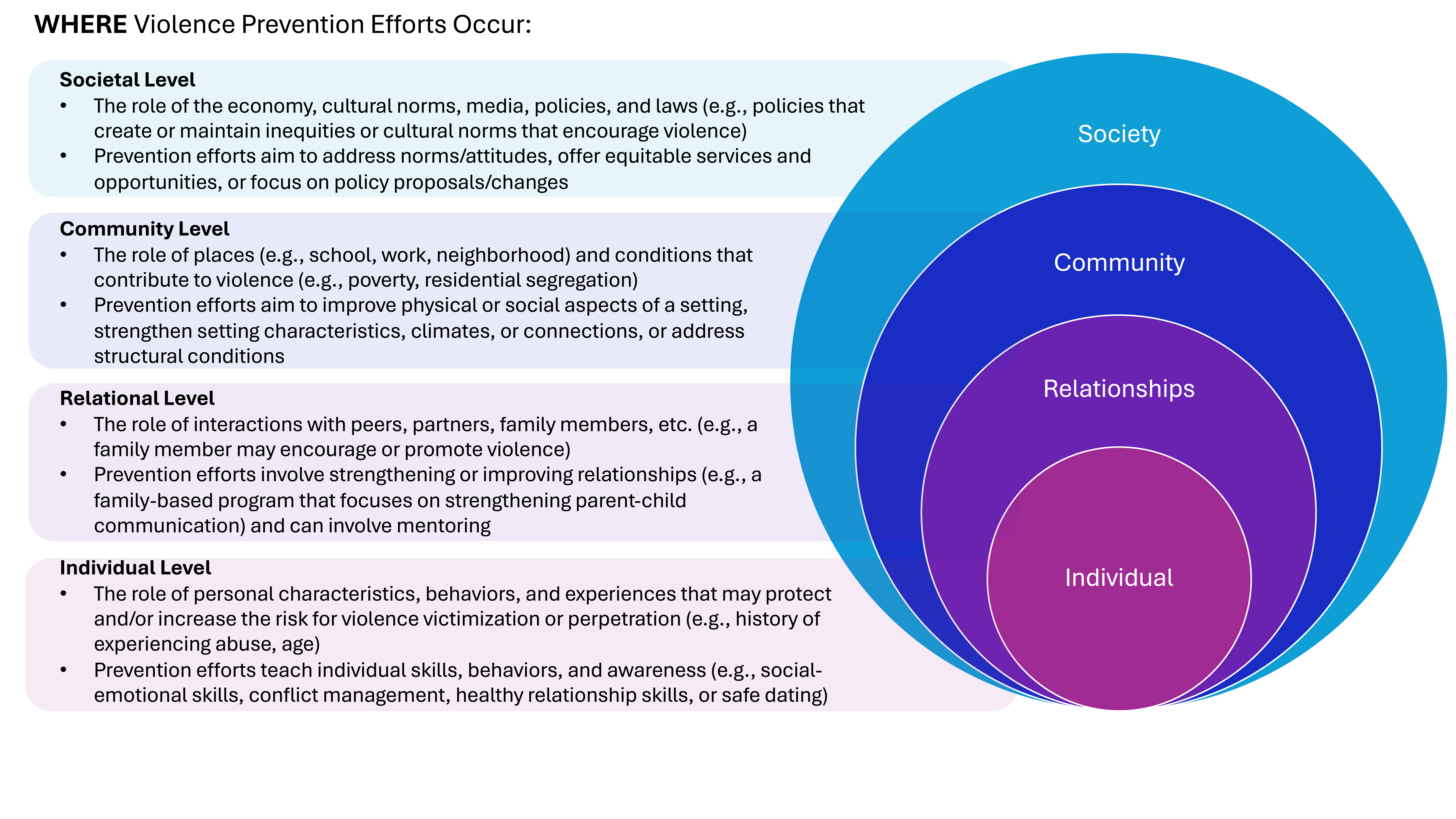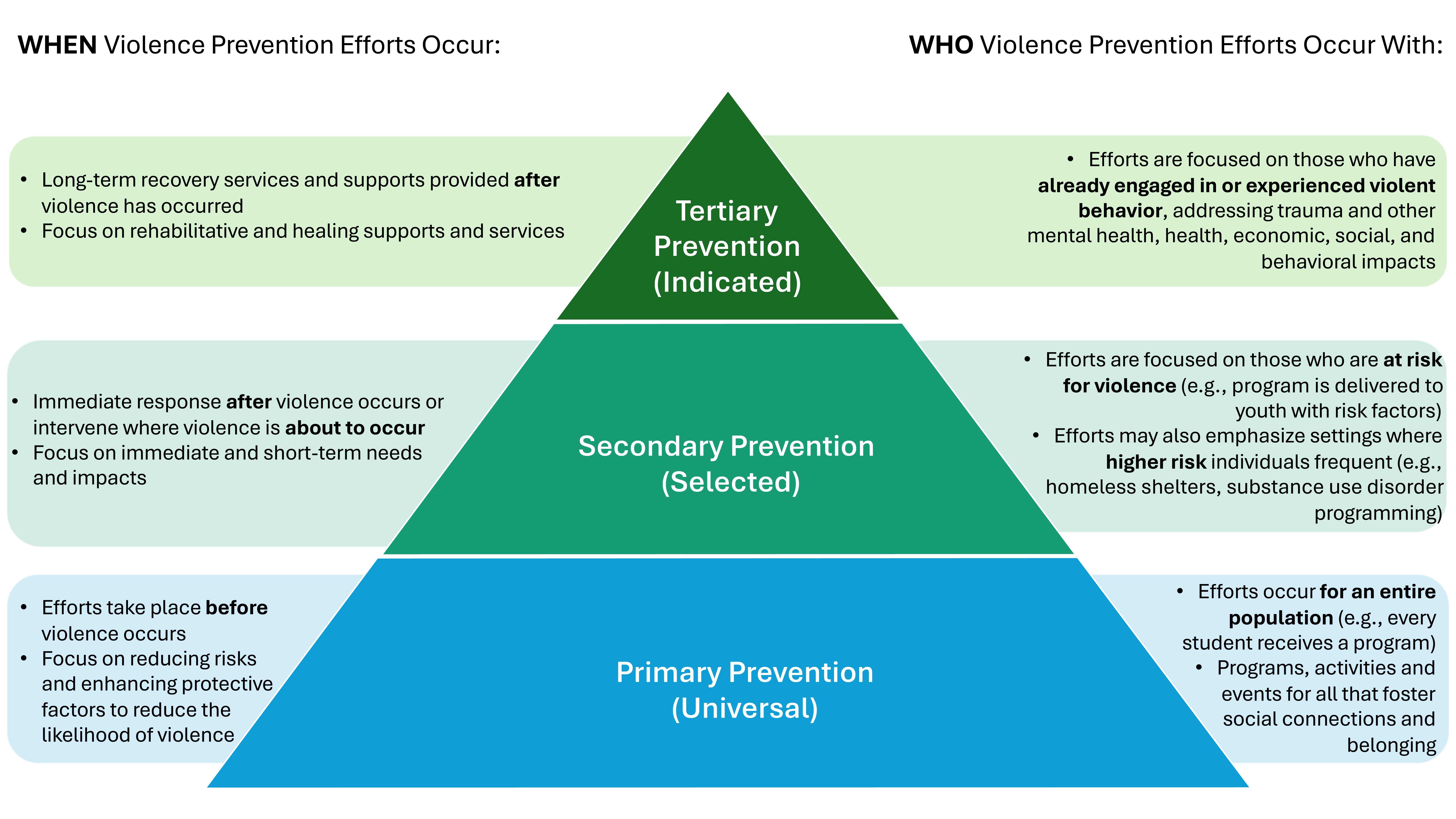Goal #1 - Prevent violence and promote health and safety through trauma-informed/healing-centered, evidence-based and comprehensive primary, secondary, and/or tertiary prevention efforts.
Understanding Goal #1 Components
To articulate components of Goal #1, we provide further definitions and graphics to describe what is meant by trauma-informed/healing-centered practices, evidence-based, and comprehensive primary, secondary, and/or tertiary prevention efforts.
Trauma-informed and healing-centered practices
The Substance Abuse and Mental Health Services Administration (SAMSHA, 2014) provides six guiding principles for trauma-informed efforts:
Safety: Within an organization or setting, clients/patients and staff feel safe physically and psychologically.
Trustworthiness and transparency: Throughout the process of care, decisions are transparent to build and sustain trust.
Peer support: Services include connecting individuals with other individuals with shared lived experiences.
Collaboration and mutuality: The power differential is eliminated to promote shared decision-making.
Empowerment, voice and choice: Clients/patients are supported in determining what they need and want for healing and the next steps they would like to pursue. Staff are seen as facilitators of healing, also empowered and supported in their work.
Cultural, historical and gender considerations: Services and organizational policies are responsive to socio-demographic and intersectional needs of participants, while also recognizing and addressing the roles of historical trauma, biases and stereotypes, and discrimination.
Trauma-informed practices realize the impact of trauma, recognize the signs and impacts of trauma among clients/patients and staff, respond by integrating knowledge of trauma into policies and practices, and resist re-traumatization (i.e., stemming from a triggering event, you are reminded of an earlier trauma; SAMHSA, 2017). For a list of key references and resources, please see:
- SAMHSA's Concept of Trauma and Guidance for Trauma-Informed Approach
- What is Trauma-Informed Care?
- CDC: Trauma-Informed Care
While trauma-informed practices are important, they are incomplete. They focus on the harm and injury resulting from trauma, individual experiences (rather than collective), and they lack a strengths-based perspective. An approach to address these limitations is called healing-centered practice, which involves "culture, spirituality, civic action and collective healing... highlighting the ways in which trauma and healing are experienced collectively." Thus, healing-centered moves away from a risk reduction model, and instead provides an asset driven and restorative approach that focuses on well-being as the goal (rather than focusing on what we want to reduce or suppress; Ginwright, 2018).
Evidence-based practices
In social services, evidence-based practices integrate the best research or evaluation evidence, clinical expertise, and participant or community values to meet the needs of a participant or community (Bent-Goodley et al., 2019). For evidence-based resources across types of violence prevention, please see: Healthy People 2030 Evidence-Based Resources
Comprehensive practices
Comprehensive practices mean addressing risk and protective factors across the social-ecological model (Wilkins et al., 2014). The social-ecological model is a useful framework for understanding where to target violence prevention efforts. As shown in Figure 1, violence prevention efforts may address factors at the individual, relational, community, or society level. These efforts may also target factors at multiple levels. Comprehensive efforts that address prevention across multiple levels of the social-ecological model are more sustainable and can have more of a long-term impact. Thus, violence prevention efforts should aim to address factors across the social-ecological model whenever possible.

For additional resources regarding the socio-ecological model and coordinated and comprehensive violence prevention efforts, please see:
WHEN Violence Prevention Efforts Occur:
"Primary, Secondary, and Tertiary Prevention Efforts" organize violence prevention approaches to specify when programming or services takes place, and who violence prevention efforts occur with. Primary prevention is considered universal, occurring for an entire population; secondary prevention is considered selected or focused on those with one or more risk factors for violence; tertiary prevention is considered indicated, or efforts for those who have already experienced or perpetrated violence (Figure 2).

Primary Prevention (Universal) Efforts take place before violence occurs Focus on reducing risks and enhancing protective factors to reduce the likelihood of violence
Secondary Prevention (Selected) Immediate response after violence occurs or intervene where violence is about to occur Focus on immediate and short-term needs and impacts
Tertiary Prevention (Indicated) Long-term recovery services and supports provided after violence has occurred Focus on rehabilitative and healing supports and services
Primary prevention efforts include programs and services that prioritize child and family support and healthy relationships and development by reducing risk factors and strengthening protective factors for an entire population. These services foster social connections and belonging.
Secondary prevention efforts include intervention programs for those at highest risk of violence (e.g., community violence interventions like street outreach, Trauma Recovery Centers, hospital-based intervention programs), focus on de-escalation and comprehensive case management, as well as clinical support for participants and their families.
WHO Violence Prevention Efforts Occur With:
Primary Prevention (Universal) Efforts occur for an entire population (e.g., every student receives a program) Programs, activities and events for all that foster social connections and belonging
Secondary Prevention (Selected) Efforts are focused on those who are at risk for violence (e.g., program is delivered to youth with risk factors) Efforts may also emphasize settings where higher risk individuals frequent (e.g., homeless shelters, substance use disorder programming)
Tertiary Prevention (Indicated) Efforts are focused on those who have already engaged in or experienced violent behavior, addressing trauma and other mental health, health, economic, social, and behavioral impacts
Tertiary prevention efforts include victim services, re-entry services, and other recovery services after violence has occurred. Approaches emphasize relationships and are focused on addressing trauma and providing long-term supports.
For additional resources on primary, secondary, and tertiary approaches to violence prevention, please see: Violence Education Tools Online
Recommendations for violence prevention programs and services:
- Honor people's complex histories (i.e., multi-generational adversity and trauma, multiple victimizations and perpetrations), and provide holistic services that address multiple forms of violence.
- Aim to engage families, schools, communities, and other important relationships and contexts in prevention efforts.
- Aim to address multiple risk and protective factors within an individual's social ecology and shared risk and protective factors.
- Focus on groups of individuals at a higher risk for violence (e.g., individuals with minoritized identities, individuals with high levels of adversity), aiming to minimize or eliminate inequities.
- Address local needs using evidence-based practices (i.e., using research or evaluation evidence, clinical expertise, and client values).
Recommendations for organizations providing violence prevention programs and services:
- Strengthen the capacity of providers to implement trauma-informed/healing-centered policies, training, and organizational practices.
- Foster culturally responsive, trauma-informed and healing-centered environments that provide safe and developmentally appropriate opportunities.
- Equip providers with developmentally and culturally appropriate screening practices and referral networks for providers to actively implement.
- Use evidence-based practices or discuss a plan for conducting an evaluation of proposed efforts.
- Support prevention staff's health and well-being using organizational trauma-informed/healing-centered practices and aiming for pay equity, to the extent possible.
Goal #2 - Advance equity by increasing access to grants and other economic opportunities
Recommendations:
- Continue improving access to funding.
- Funding opportunities should be flexible to accommodate the priorities identified by the local community and support the unique traits and strengths of grassroots community organizations that are doing this work but have been unable to gain access to federal or state resources.
- Funding notices should use accessible language.
- The application review process should include community members.
- Provide incentives, such as extra application points, to disenfranchised agencies and communities; for addressing underserved groups; and/or for the applicant agency's board and leadership to engage in racial equity training and planning.
- Provide more support for small and medium-sized organizations.
- Conduct active and rigorous outreach to communities and provide accessible education on upcoming solicitations and capacity building opportunities (e.g., in areas of writing grants and budgets, proposing implementation or evaluation plans).
- Develop a mentoring program so small and medium-sized, or new organizations can learn from more experienced or larger organizations.
- Enhance capacity building curricula, and its accessibility, for prospective grantees and current grantees.
- Improve reimbursement and budget processes.
- Improve the overall infrastructure for reimbursements, streamlining budgetary and reporting requirements to reduce burden on grantees.
- Evaluate the workflow within fiscal and grant departments to identify opportunities that will decrease time to reimbursement.
- Enhance grantee budgetary and reporting training.
- Prioritize pay equity across community agencies (to the extent possible), investing in people in the local community who provide support for those impacted by violence.
- Promote and connect grantee work.
- Develop media and materials to promote the exceptional work of violence prevention grantees.
- Foster grantee engagement activities throughout implementation.
- Improve systems and communication.
- Update grant monitoring systems and include a more centralized approach (e.g., where to submit and track reports, budgets, requests).
- Encourage communication between state agencies to increase use of best practices for Notice of Funding Opportunities, reporting, budgets, and training.
Goal #3 - Promote collaboration across state, municipal, and community-based agencies, informed by research and data, sharing of best practices and lessons learned, and ongoing discussions
Recommendations:
- Analyze and disseminate statewide data trends, and continue to collect data to inform future violence prevention planning efforts. This ongoing data analysis and collection should incorporate youth, family, and community feedback and utilize quantitative and qualitative evaluation methods, including rigorous comparison group data. ICJIA should determine its capacity to complete this objective internally or through a contract with research partners.
- Coordinate violence prevention funding in Illinois by continuing the Ad Hoc Violence Prevention Committee under the ICJIA Board structure.
- Identify and invite organizations to address missing representation.
- Convene a quarterly meeting in which committee members stay in conversation with each other. Regular communication and convening fosters collaboration between agencies. This committee will determine sub-committee projects.
- Identify possible projects, key contacts within agencies, and develop a project timeline. This collaborative project should include at least two state agencies and relevant community partners.
- Host a statewide violence prevention event to highlight research and program evaluation findings, as well as the work of community-based organizations leading violence prevention work. This event could also encourage governmental partnerships and build community across grantees, evaluators, governmental officials, stakeholders, and researchers.
